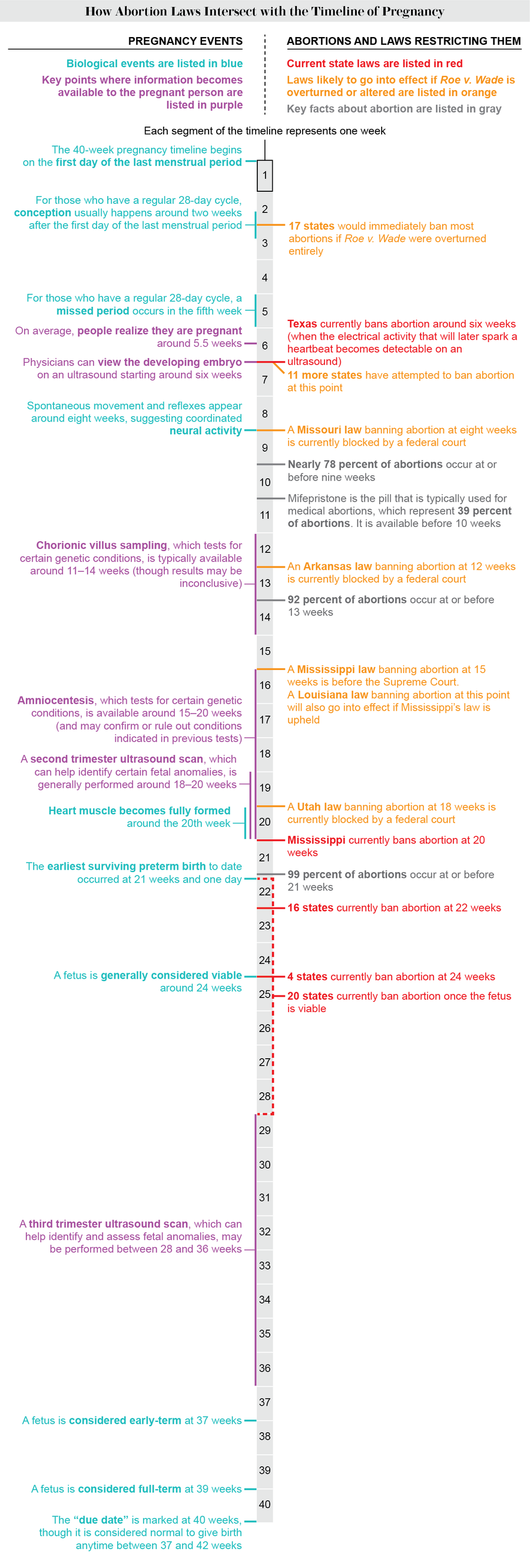On December 1 the U.S. Supreme Court will hearopening arguments for what could become a momentous case. Jackson Women’s Health Organization, Mississippi’s only abortion facility, sued the state over a 2018 law that has attempted to ban most abortions conducted after 15 weeks of gestation, which is just 13 weeks after conception. The regulation directly challenges the Supreme Court’s 1973 Roe v. Wade ruling, which prevents states from outlawing abortions before “viability”—the point at which a fetus could survive outside the womb, which is generally around 24 weeks of gestation.
More than 90 percent of abortions in the U.S. occur at or before 13 weeks of gestation, and most do so much earlier. But the verdict of the Mississippi case, which will come next year, could still have major implications for people deciding whether to carry a pregnancy to term. For instance, many severe birth defects and developmental disorders—including some that will lead to stillbirths or potentially cause health risks to the pregnant person—cannot be detected until as late as 20 weeks—or even later. And if the court rules broadly to allow pre-viability bans, that will open the door for numerous states to institute their own versions. Twelve states have “trigger laws” that will likely immediately outlaw most abortions if Roe is overturned. Of states without such triggers, five already technically ban the procedure but cannot enforce their laws because Roe overrides state regulations. And several states have passed or proposed laws that would prohibit abortions after as early as six weeks.
The majority of the Supreme Court’s current members lean politically conservative, and experts say the Mississippi ruling is likely to weaken the protections granted by Roe, if not eliminate them entirely. The court already declined to intervene when, in September, Texas made it a crime to help a woman seek an abortion once an ultrasound scan can detect the electrical activity that will later spark a fetus’s heartbeat. Such activity generally begins around six weeks into pregnancy, and the regulation amounts to a near-total ban because many people do not even know they are pregnant at that point. A study released by the University of Texas at Austin on October 29 found that the number of legal abortions in the statedropped by half during the first month that the law was in effect. The Supreme Court has signaled it might allow a challenge to that law.
On supporting science journalism
If you're enjoying this article, consider supporting our award-winning journalism by subscribing. By purchasing a subscription you are helping to ensure the future of impactful stories about the discoveries and ideas shaping our world today.
The Mississippi ruling could also affect several states that have already passed previability bans—a 2013 law in Arkansas, for instance, prohibits abortions after 12 weeks—but they have been blocked by federal courts. These states are likely to revisit their laws, which could leave pregnant people with little time to make a decision. Those who cannot afford an abortion may not be able to raise enough money before their state’s cutoff date, and they may be unable to afford to travel out of state.
Researchers already know a great deal about the effect on people who are denied an abortion. A landmark project called the Turnaway Study tracked nearly 1,000 women who either had an abortion or were turned away from clinics because their pregnancy was too advanced. The women in the latter group, who were forced to carry their pregnancy to term, were four times more likely to fall below the poverty line during the next five years. They also reported poorer overall health and more chronic pain.
Here we present a timeline of pregnancy, showing how active and proposed abortion bans intersect with both biological development and a pregnant person’s ability to make decisions.

Credit: Amanda Montañez
